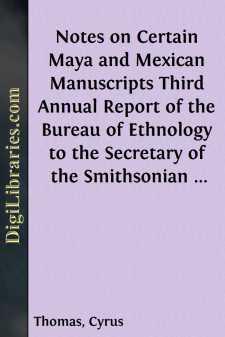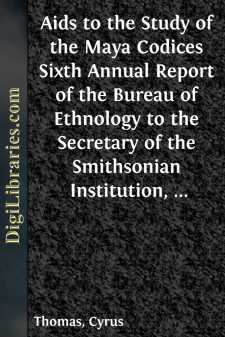Categories
- Antiques & Collectibles 13
- Architecture 36
- Art 48
- Bibles 22
- Biography & Autobiography 813
- Body, Mind & Spirit 142
- Business & Economics 28
- Children's Books 17
- Children's Fiction 14
- Computers 4
- Cooking 94
- Crafts & Hobbies 4
- Drama 346
- Education 46
- Family & Relationships 57
- Fiction 11829
- Games 19
- Gardening 17
- Health & Fitness 34
- History 1377
- House & Home 1
- Humor 147
- Juvenile Fiction 1873
- Juvenile Nonfiction 202
- Language Arts & Disciplines 88
- Law 16
- Literary Collections 686
- Literary Criticism 179
- Mathematics 13
- Medical 41
- Music 40
- Nature 179
- Non-Classifiable 1768
- Performing Arts 7
- Periodicals 1453
- Philosophy 64
- Photography 2
- Poetry 896
- Political Science 203
- Psychology 42
- Reference 154
- Religion 513
- Science 126
- Self-Help 84
- Social Science 81
- Sports & Recreation 34
- Study Aids 3
- Technology & Engineering 59
- Transportation 23
- Travel 463
- True Crime 29
Notes on Certain Maya and Mexican Manuscripts Third Annual Report of the Bureau of Ethnology to the Secretary of the Smithsonian Institution, 1881-82, Government Printing Office, Washington, 1884, pages 3-66
by: Cyrus Thomas
Categories:
Description:
Excerpt
“TABLEAU DES BACAB.”
Having recently come into possession of Leon de Rosny’s late work entitled “Les Documents ecrits de l’Antiquite Americaine,” I find in it a photo-lithographic copy of two plates (or rather one plate, for the two are but parts of one) of the Maya Manuscript known as the Codex Cortesianus. This plate (I shall speak of the two as one) is of so much importance in the study of the Central American symbols and calendar systems that I deem it worthy of special notice; more particularly so as it furnishes a connecting link between the Maya and Mexican symbols and calendars.
This plate (Nos. 8 and 9 in Rosny’s work), is entitled by Rosny “Tableau des Bacab” or “Plate of the Bacabs,” he supposing it to be a representation of the gods of the four cardinal points, an opinion I believe to be well founded.
As will be seen by reference to our , which is an exact copy from Rosny’s work, this page consists of three divisions: First, an inner quadrilateral space, in which there are a kind of cross or sacred tree; two sitting figures, one of which is a female, and six characters. Second, a narrow space or belt forming a border to the inner area, from which it is separated by a single line; it is separated from the outer space by a double line. This space contains the characters for the twenty days of the Maya month, but not arranged in consecutive order. Third, an outer and larger space containing several figures and numerous characters, the latter chiefly those representing the Maya days. This area consists of two distinct parts, one part containing day characters, grouped together at the four corners, and connected by rows of dots running from one group to the other along the outer border; the other part consisting of four groups of figures, one group opposite each of the four sides. In each of the four compartments containing these last-mentioned groups, there is one of the four characters shown in (a b c d), which, in my “Study of the Manuscript Troano,” I have concluded represent the four cardinal points, a conclusion also reached independently by Rosny and
Before entering upon the discussion of this plate I will insert here Rosny’s comment, that the reader may have an opportunity of comparing his view of its signification with the opinion I shall advance.
I intend to close this report with some observations on the criticisms which have been written since the publication of my “Essay on the Decipherment of the Hieratic Writings,” as much, regarding the first data, for which we are indebted to Diego de Landa, as that of the method to follow in order to realize new progress in the interpretation of the Katounic texts. I will be permitted, however, before approaching this discussion, to say a word on two leaves of the Codex Cortesianus, which not only confirm several of my former lectures, but which furnish us probably a more than ordinarily interesting document relative to the religious history of ancient Yucatan....




